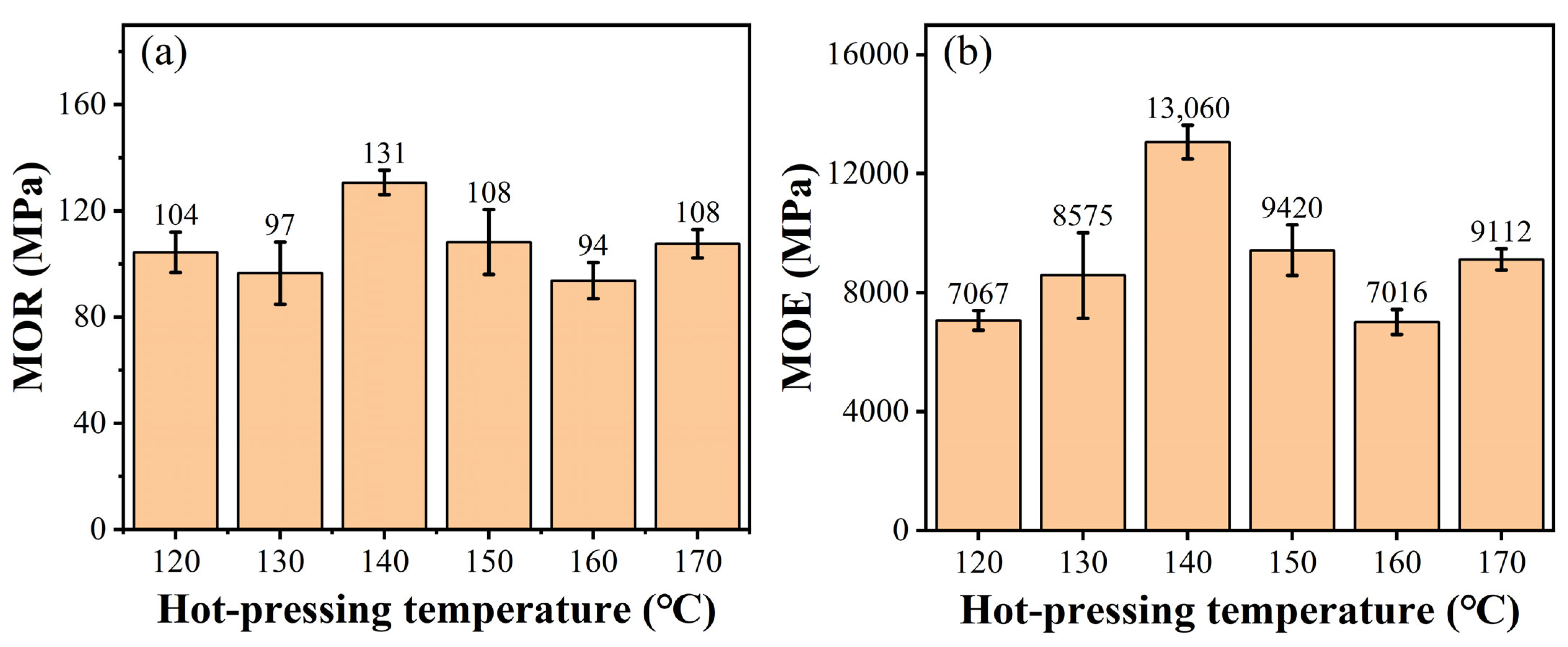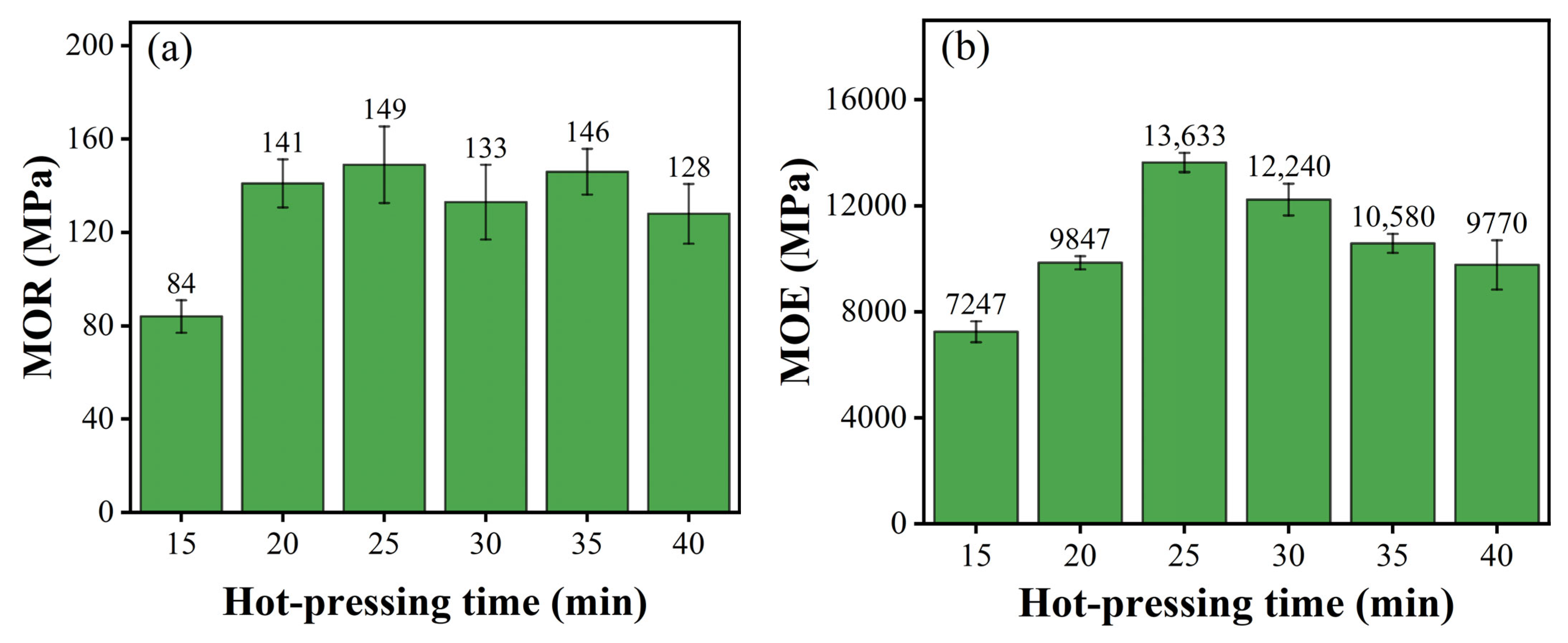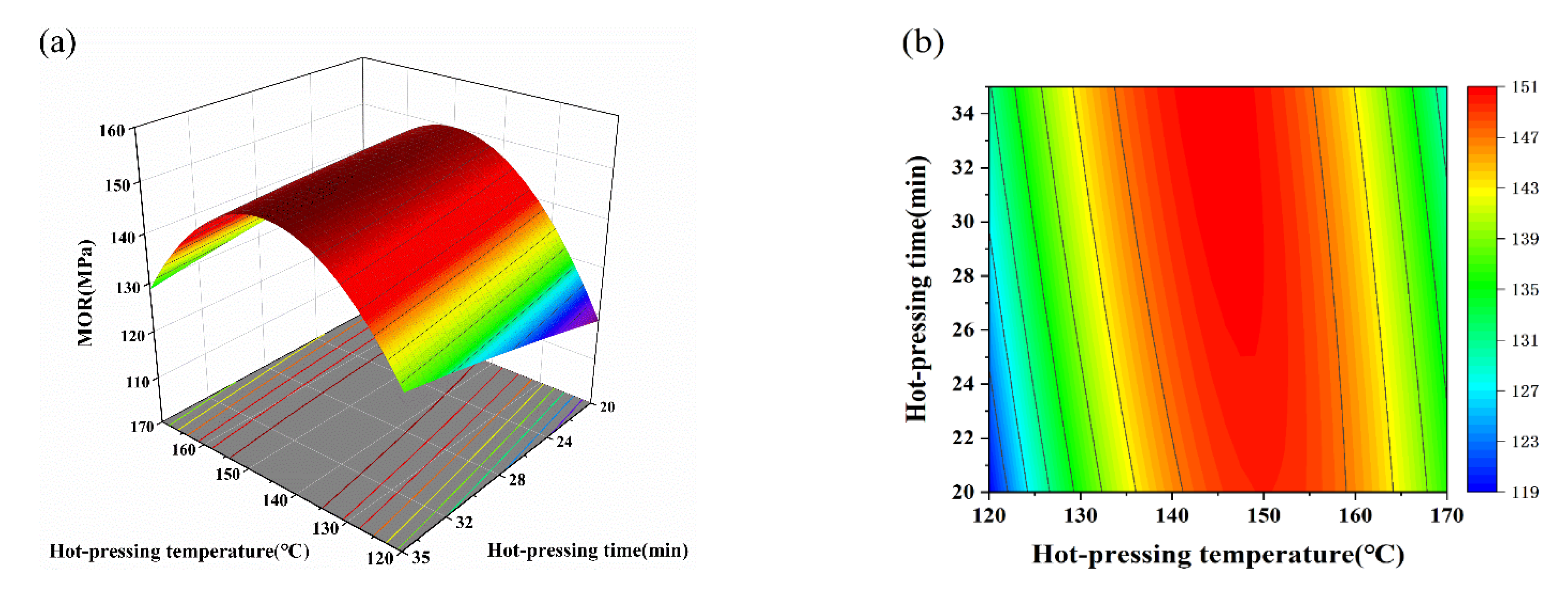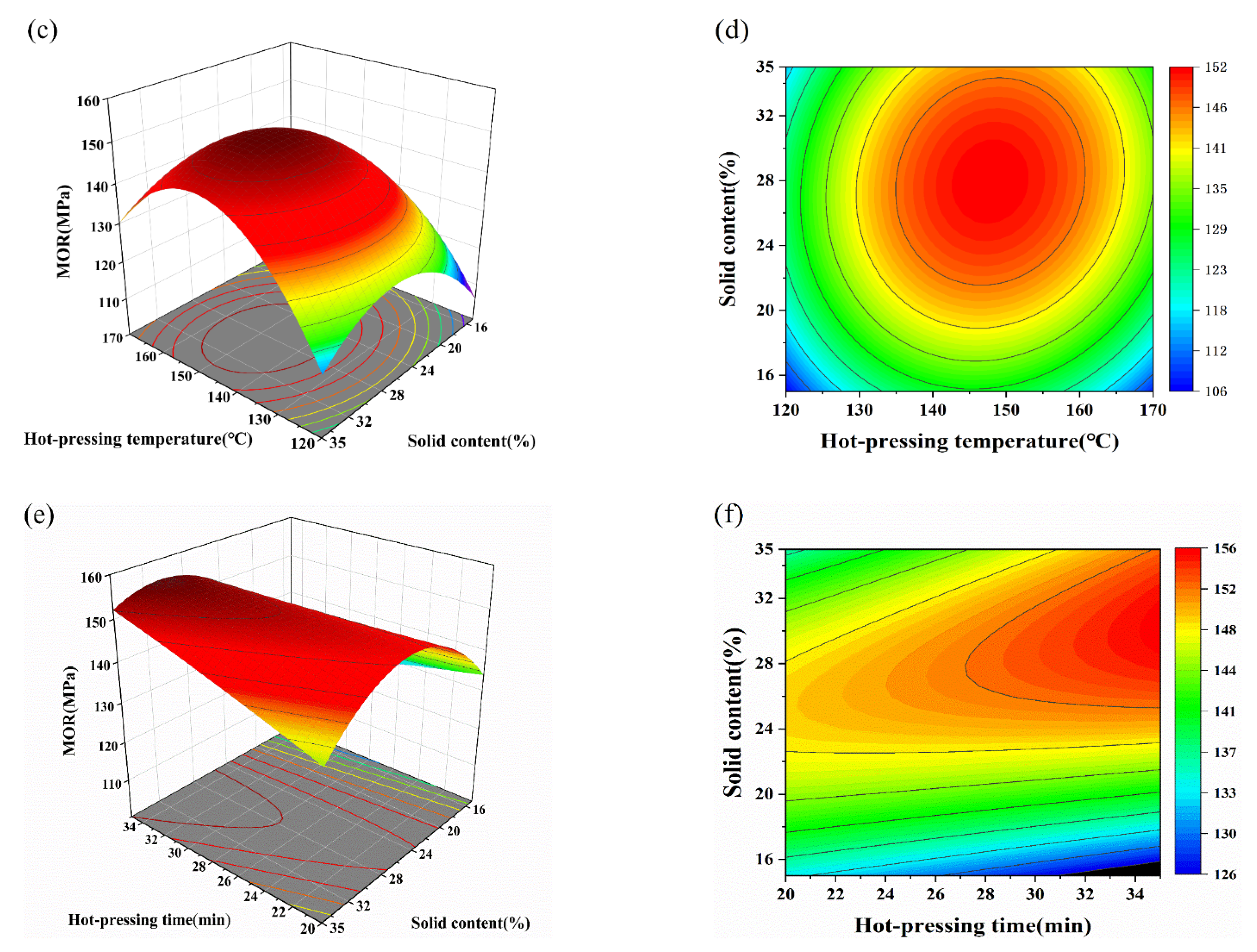Optimizing the Preparation Process of Bamboo Scrimber with Bamboo Waste Bio-Oil Phenolic Resin Using Response Surface Methodology
Abstract
:1. Introduction
2. Materials and Methods
2.1. Materials
2.2. Preparation of Bamboo Scrimber
2.3. Experimental Design
2.3.1. Single-Factor Experiment Design
| Factors | Level |
|---|---|
| Hot-pressing temperature (°C) | 120, 130, 140, 150, 160, 170 |
| Hot-pressing time (min) | 15, 20, 25, 30, 35, 40 |
| Solid content (%) | 15, 20, 25, 30, 35, 40 |
2.3.2. Multi-Factor Experiment Design
2.4. Performance Testing
3. Results and Discussion
3.1. Single-Factor Experiment
3.1.1. Effect of Hot-Pressing Temperature
3.1.2. Effect of Hot-Pressing Time
3.1.3. Effect of Adhesive Solid Content
3.2. Multi-Factor Experiment
3.2.1. Variance Analysis
Variance Analysis of MOR
Variance Analysis of MOE
3.2.2. Effects of Interactions between Factors
Effect of the Interactions on MOR
Effect of the Interaction on MOE
3.3. Optimization and Validation
4. Conclusions
Author Contributions
Funding
Data Availability Statement
Conflicts of Interest
References
- Zheng, Z.Y.; Yan, N.A.; Lou, Z.C.; Jiang, X.Z.; Zhang, X.M.; Chen, S.; Xu, R.; Liu, C.; Xu, L. Modification and Application of Bamboo-Based Materials: A Review-Part I: Modification Methods and Mechanisms. Forests 2023, 14, 2219. [Google Scholar] [CrossRef]
- Adier, M.F.V.; Sevilla, M.E.P.; Valerio, D.N.R.; Ongpeng, J.M.C.; Sadowski, T. Bamboo as Sustainable Building Materials: A Systematic Review of Properties, Treatment Methods, and Standards. Buildings 2023, 13, 2449. [Google Scholar] [CrossRef]
- Aizuddin, K.; Lai, K.S.; Baharum, N.A.; Yong, W.T.L.; Hoon, L.N.; Hamid, M.Z.A.; Cheng, W.H.; Abdullah, J.O. Bamboo for Biomass Energy Production. Bioresources 2023, 18, 2386–2407. [Google Scholar] [CrossRef]
- Kaur, P.J.; Yadav, P.; Gupta, M.; Khandegar, V.; Jain, A. Bamboo as a Source for Value Added Products: Paving Way to Global Circular Economy. Bioresources 2022, 17, 5437–5463. [Google Scholar] [CrossRef]
- Kunyong, Y.; Jian, L.; Terefe, R. Role of Bamboo Forest for Mitigation and Adaptation to Climate Change Challenges in China. J. Sci. Res. Rep. 2019, 24, 1–7. [Google Scholar]
- Pan, C.; Zhou, G.; Shrestha, A.K.; Chen, J.; Kozak, R.; Li, N.; Li, J.; He, Y.; Sheng, C.; Wang, G. Bamboo as a Nature-Based Solution (NbS) for Climate Change Mitigation: Biomass, Products, and Carbon Credits. Climate 2023, 11, 175. [Google Scholar] [CrossRef]
- Shu, B.; Xiao, Z.; Hong, L.; Zhang, S.; Li, C.; Fu, N.; Lu, X. Review on the Application of Bamboo-Based Materials in Construction Engineering. J. Renew. Mater. 2020, 8, 1215–1242. [Google Scholar] [CrossRef]
- Sun, X.; He, M.; Li, Z. Novel engineered wood and bamboo composites for structural applications: State-of-art of manufacturing technology and mechanical performance evaluation. Constr. Build. Mater. 2020, 249, 118751. [Google Scholar] [CrossRef]
- Bala, A.; Gupta, S. Engineered bamboo and bamboo-reinforced concrete elements as sustainable building materials: A review. Constr. Build. Mater. 2023, 394, 132116. [Google Scholar] [CrossRef]
- Xu, J.Y.; Zhou, Z.Z.; Zhang, X.C.; Xu, Y.T. A Simple and Effective Method to Enhance the Mechanical Properties, Dimensional Stability, and Mildew Resistance of Bamboo Scrimber. Polymers 2023, 15, 4162. [Google Scholar] [CrossRef]
- Wei, J.G.; Xu, Y.; Bao, M.Z.; Yu, Y.L.; Yu, W.J. Effect of Resin Content on the Surface Wettability of Engineering Bamboo Scrimbers. Coatings 2023, 13, 203. [Google Scholar] [CrossRef]
- Tang, S.Y.; Zhou, A.P.; Li, J.N. Mechanical Properties and Strength Grading of Engineered Bamboo Composites in China. Adv. Civ. Eng. 2021, 2021, 666059. [Google Scholar] [CrossRef]
- Li, X.Y.; Rao, F.; Li, N.; Lei, W.C.; Bao, M.Z.; Bao, Y.J.; Li, L.M.; Duan, Z.J.; Zu, Q.; Zhang, Y.H.; et al. High-performance bamboo scrimber composite prepared from heat-treated Bambusa chungii units with different resin contents for outdoor use. Ind. Crops Prod. 2023, 205, 117503. [Google Scholar] [CrossRef]
- Xie, J.L.; Chen, L.; Yang, L.; Jiang, Y.Z.; Chen, Q.; Qi, J.Q. Physical-mechanical properties of bamboo scrimbers with response to surface layer modification: Thermal treatment and resin dosage. Eur. J. Wood Wood Prod. 2023, 82, 321–328. [Google Scholar] [CrossRef]
- Gao, M.; Wu, W.H.; Wang, Y.H.; Wang, Y.X.; Wang, H. Phenolic foam modified with dicyandiamide as toughening agent. J. Therm. Anal. Calorim. 2016, 124, 189–195. [Google Scholar] [CrossRef]
- Hendrik, J.; Hadi, Y.S.; Massijaya, M.Y.; Santoso, A.; Park, B.D. Penetration and Adhesion Strength of Phenol-Tannin-Formaldehyde Resin Adhesives for Bonding Three Tropical Woods. For. Prod. J. 2018, 68, 256–263. [Google Scholar]
- Karthäuser, J.; Biziks, V.; Mai, C.; Militz, H. Lignin and Lignin-Derived Compounds for Wood Applications—A Review. Molecules 2021, 26, 2533. [Google Scholar] [CrossRef] [PubMed]
- Zhang, W.Z.; Jiang, N.; Zhang, T.T.; Li, T.S. Thermal stability and thermal degradation study of phenolic resin modified by cardanol. Emerg. Mater. Res. 2020, 9, 180–185. [Google Scholar] [CrossRef]
- Yu, Y.X.; Li, C.; Jiang, C.X.; Chang, J.M.; Shen, D.N. Aging Behaviors of Phenol-Formaldehyde Resin Modified by Bio-Oil under Five Aging Conditions. Polymers 2022, 14, 1352. [Google Scholar] [CrossRef]
- Yildiz, D.; Yorgun, S. Catalytic pyrolysis of Paulownia wood and bio-oil characterization. Energy Sources Part A Recovery Util. Environ. Eff. 2024, 46, 1626–1643. [Google Scholar] [CrossRef]
- Kato, Y.; Kohnosu, T.; Enomoto, R. Chemical properties of bio-oils produced by fast pyrolysis of bamboo. Trans. Mater. Res. Soc. Jpn. 2014, 39, 491–498. [Google Scholar] [CrossRef]
- Li, Q.; Liu, X.S.; Su, H.D.; Mao, A.; Wan, H. Improving Performance of Phenol-Formaldehyde Resins Modified/Blended with Phenol-Rich Pyrolysis Bio-Oil. For. Prod. J. 2020, 70, 387–395. [Google Scholar] [CrossRef]
- Khanal, A.; Manandhar, A.; Adhikari, S.; Shah, A. Techno-economic analysis of novolac resin production by partial substitution of petroleum-derived phenol with bio-oil phenol. Biofuels Bioprod. Biorefining Biofpr 2021, 15, 1611–1620. [Google Scholar] [CrossRef]
- Li, C.M.; Ren, X.Y.; Han, S.Y.; Li, Y.X.; Chen, F.M. The Preparation and Performance of Bamboo Waste Bio-Oil Phenolic Resin Adhesives for Bamboo Scrimber. Forests 2024, 15, 79. [Google Scholar] [CrossRef]
- Lu, T.; Ge, Y.L.; Zhou, C.F.; Ren, Y.M.; He, M.Y.; Xu, K.; Li, X.J. Effects of physical parameters on the temperature and vapor-pressure behavior of bamboo scrimber during hot-pressing. Wood Mater. Sci. Eng. 2023, 18, 1641–1649. [Google Scholar] [CrossRef]
- Ji, Y.H.; Lei, W.C.; Huang, Y.X.; Wu, J.Y.; Yu, W.J. Influence of Resin Content and Density on Water Resistance of Bamboo Scrimber Composite from a Bonding Interface Structure Perspective. Polymers 2022, 14, 1865. [Google Scholar] [CrossRef] [PubMed]
- Kumari, P.; Kaur, P.; Kumar, V.; Pandey, B.; Nazir, R.; Katoch, K.; Dwivedi, P.; Dey, A.; Pandey, D.K. Response surface methodology and artificial neural network modeling for optimization of ultrasound-assisted extraction and rapid HPTLC analysis of asiaticoside from Centella asiatica. Ind. Crops Prod. 2022, 176, 114320. [Google Scholar] [CrossRef]
- Hadiyat, M.A.; Sopha, B.M.; Wibowo, B.S. Response Surface Methodology Using Observational Data: A Systematic Literature Review. Appl. Sci. 2022, 12, 10663. [Google Scholar] [CrossRef]
- Niu, X.Y.; Pang, J.Y.; Cai, H.Z.; Li, S.; Le, L.; Wu, J.H. Process Optimization of Large-Size Bamboo Bundle Laminated Veneer Lumber (BLVL) by Box-Behnken Design. Bioresources 2018, 13, 1401–1412. [Google Scholar] [CrossRef]
- GB/T 17657-2022; Test Methods for Physical and Chemical Properties of Artificial Boards and Decorative Artificial Boards. GB Standards: Beijing, China, 2022.
- Kiho, J.; Jung, K.Y.; Roh, J.; Jin, P.S. Effect of Hot-Pressing Time and Temperature on Properties of Bamboo Zephyr Boards. J. Korean Wood Sci. Technol. 2003, 31, 77–83. [Google Scholar]
- GB/T 40247-2021; Bamboo Scrimber. GB Standards: Beijing, China, 2021.
- Li, H.; Chen, M.L.; Hu, L.X.; Wang, X.; Gu, Z.C.; Li, J.Z.; Yang, Z.B. Optimization Design of Bamboo Filament Decorated Board Process Based on Response Surface. Bioresources 2023, 18, 73–86. [Google Scholar] [CrossRef]
- Kazemian, A.; Basati, Y.; Khatibi, M.; Ma, T. Performance prediction and optimization of a photovoltaic thermal system integrated with phase change material using response surface method. J. Clean. Prod. 2021, 290, 125748. [Google Scholar] [CrossRef]
- Watts, E.S.; Rose, S.P.; Mackenzie, A.M.; Pirgozliev, V.R. Investigations into the chemical composition and nutritional value of single-cultivar rapeseed meals for broiler chickens. Arch. Anim. Nutr. 2021, 75, 209–221. [Google Scholar] [CrossRef] [PubMed]
- Omranian, S.R.; Hamzah, M.O.; Yee, T.S.; Hasan, M.R.M. Effects of short-term ageing scenarios on asphalt mixtures’ fracture properties using imaging technique and response surface method. Int. J. Pavement Eng. 2020, 21, 1374–1392. [Google Scholar] [CrossRef]
- Zhang, R.B.; Liu, T.; Zhang, Y.M.; Cai, Z.L.; Yuan, Y.Z. Preparation of spent fluid catalytic cracking catalyst-metakaolin based geopolymer and its process optimization through response surface method. Constr. Build. Mater. 2020, 264, 120727. [Google Scholar] [CrossRef]
- Wang, H.Y.; Yuan, S.F.; Zhang, J.; Li, Q. Influence of Four Ageing Methods on the Mechanical Properties of Bamboo Scrimber. Int. J. Polym. Sci. 2021, 2021, 2478525. [Google Scholar] [CrossRef]









| Factors | Code | Level | ||
|---|---|---|---|---|
| Low (−1) | Middle (0) | High (1) | ||
| Hot-pressing temperature (°C) | A | 120 | 145 | 170 |
| Hot-pressing time (min) | B | 20 | 27.5 | 35 |
| Solid content (%) | C | 15 | 25 | 35 |
| Run | A | B | C | MOR (MPa) | MOE (MPa) |
|---|---|---|---|---|---|
| 1 | 0 | 1 | −1 | 117.35 | 7300 |
| 2 | 0 | 0 | 0 | 151.56 | 12,733 |
| 3 | 1 | 0 | 1 | 131.76 | 12,155 |
| 4 | 1 | 1 | 0 | 133.73 | 8960 |
| 5 | 1 | 0 | −1 | 107.57 | 9112 |
| 6 | −1 | 0 | −1 | 104.40 | 7067 |
| 7 | −1 | −1 | 0 | 113.69 | 7613 |
| 8 | −1 | 0 | 1 | 115.74 | 10,488 |
| 9 | 0 | 0 | 0 | 156.60 | 13,030 |
| 10 | 0 | 1 | 1 | 145.45 | 10,580 |
| 11 | 0 | 0 | 0 | 145.32 | 11,327 |
| 12 | 0 | 0 | 0 | 158.52 | 12,828 |
| 13 | 0 | 0 | 0 | 142.04 | 13,260 |
| 14 | 1 | −1 | 0 | 129.69 | 11,380 |
| 15 | 0 | −1 | −1 | 140.52 | 9665 |
| 16 | −1 | 1 | 0 | 137.13 | 8296 |
| 17 | 0 | −1 | 1 | 140.92 | 9847 |
| Response Variables | R2-Value | CV (%) |
|---|---|---|
| MOR | 0.9136 | 6.18 |
| MOE | 0.9492 | 6.84 |
| Source | Sum of Square | DF | Mean Square | F-Value | Prob > F | Significance |
|---|---|---|---|---|---|---|
| Model | 3985.76 | 9 | 442.86 | 6.48 | 0.0111 | significant |
| A | 126.34 | 1 | 126.34 | 1.85 | 0.2160 | |
| B | 9.76 | 1 | 9.76 | 0.14 | 0.7166 | |
| C | 512.48 | 1 | 512.48 | 7.50 | 0.0289 | |
| AB | 94.07 | 1 | 94.07 | 1.38 | 0.2789 | |
| AC | 41.28 | 1 | 41.28 | 0.60 | 0.4623 | |
| BC | 191.82 | 1 | 191.82 | 2.81 | 0.1377 | |
| A2 | 1986.44 | 1 | 1986.44 | 29.09 | 0.0010 | |
| B2 | 1.17 | 1 | 1.17 | 0.017 | 0.8994 | |
| C2 | 851.40 | 1 | 851.40 | 12.47 | 0.0096 | |
| Residual | 478.05 | 7 | 68.29 | |||
| Lack of Fit | 277.46 | 3 | 92.49 | 1.84 | 0.2795 | not significant |
| Pure Error | 200.58 | 4 | 50.15 | |||
| Cor Total | 4463.80 | 16 |
| Source | Sum of Square | DF | Mean Square | F-Value | Prob > F | Significance |
|---|---|---|---|---|---|---|
| Model | 6.529 × 107 | 9 | 7.254 × 106 | 14.52 | 0.0010 | significant |
| A | 8.289 × 106 | 1 | 8.289 × 106 | 16.59 | 0.0047 | |
| B | 1.419 × 106 | 1 | 1.419 × 106 | 2.84 | 0.1358 | |
| C | 1.232 × 107 | 1 | 1.232 × 107 | 24.65 | 0.0016 | |
| AB | 2.407 × 106 | 1 | 2.407 × 106 | 4.82 | 0.0642 | |
| AC | 3.572 × 104 | 1 | 3.572 × 104 | 0.072 | 0.7969 | |
| BC | 2.399 × 106 | 1 | 2.399 × 106 | 4.80 | 0.0645 | |
| A2 | 1.089 × 107 | 1 | 1.089 × 107 | 21.79 | 0.0023 | |
| B2 | 1.626 × 107 | 1 | 1.626 × 107 | 32.56 | 0.0007 | |
| C2 | 7.361 × 106 | 1 | 7.361 × 106 | 14.73 | 0.0064 | |
| Residual | 3.497 × 106 | 7 | 4.996 × 105 | |||
| Lack of Fit | 1.192 × 106 | 3 | 3.975 × 105 | 0.69 | 0.6040 | not significant |
| Pure Error | 2.304 × 106 | 4 | 5.761 × 105 | |||
| Cor Total | 6.879 × 107 | 16 |
| Sample | MOR (MPa) | MOE (MPa) | WSR (%) | TSR (%) |
|---|---|---|---|---|
| 1 | 150.40 ± 11.95 | 11,547 ± 378.00 | 2.19 ± 0.26 | 11.72 ± 1.11 |
| 2 | 153.04 ± 15.70 | 13,560 ± 153.04 | 1.86 ± 0.12 | 6.18 ± 1.15 |
| 3 | 146.70 ± 7.11 | 13,300 ± 146.70 | 1.82 ± 0.09 | 8.14 ± 0.91 |
Disclaimer/Publisher’s Note: The statements, opinions and data contained in all publications are solely those of the individual author(s) and contributor(s) and not of MDPI and/or the editor(s). MDPI and/or the editor(s) disclaim responsibility for any injury to people or property resulting from any ideas, methods, instructions or products referred to in the content. |
© 2024 by the authors. Licensee MDPI, Basel, Switzerland. This article is an open access article distributed under the terms and conditions of the Creative Commons Attribution (CC BY) license (https://creativecommons.org/licenses/by/4.0/).
Share and Cite
Li, Y.; Li, C.; Ren, X.; Chen, F.; Chen, L. Optimizing the Preparation Process of Bamboo Scrimber with Bamboo Waste Bio-Oil Phenolic Resin Using Response Surface Methodology. Forests 2024, 15, 1173. https://doi.org/10.3390/f15071173
Li Y, Li C, Ren X, Chen F, Chen L. Optimizing the Preparation Process of Bamboo Scrimber with Bamboo Waste Bio-Oil Phenolic Resin Using Response Surface Methodology. Forests. 2024; 15(7):1173. https://doi.org/10.3390/f15071173
Chicago/Turabian StyleLi, Ying, Chunmiao Li, Xueyong Ren, Fuming Chen, and Linbi Chen. 2024. "Optimizing the Preparation Process of Bamboo Scrimber with Bamboo Waste Bio-Oil Phenolic Resin Using Response Surface Methodology" Forests 15, no. 7: 1173. https://doi.org/10.3390/f15071173






